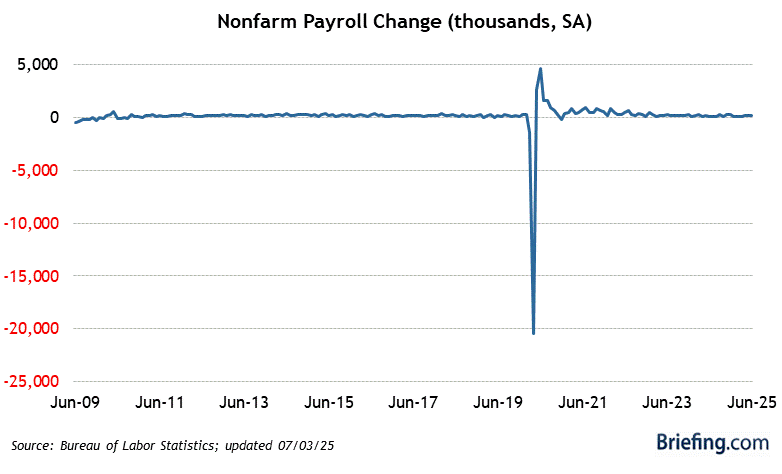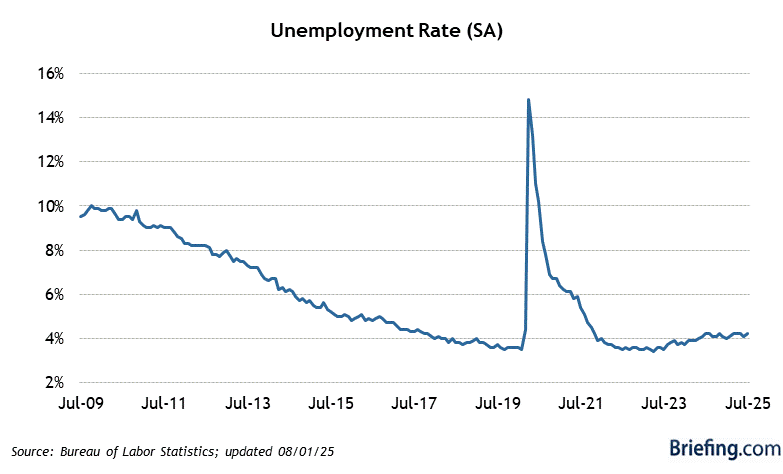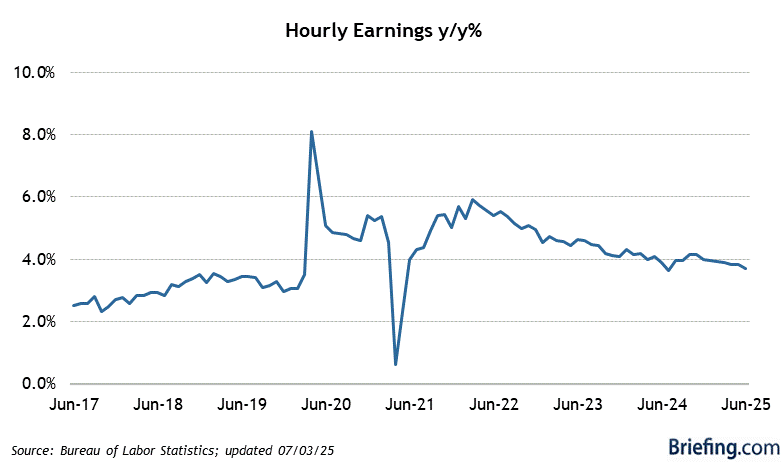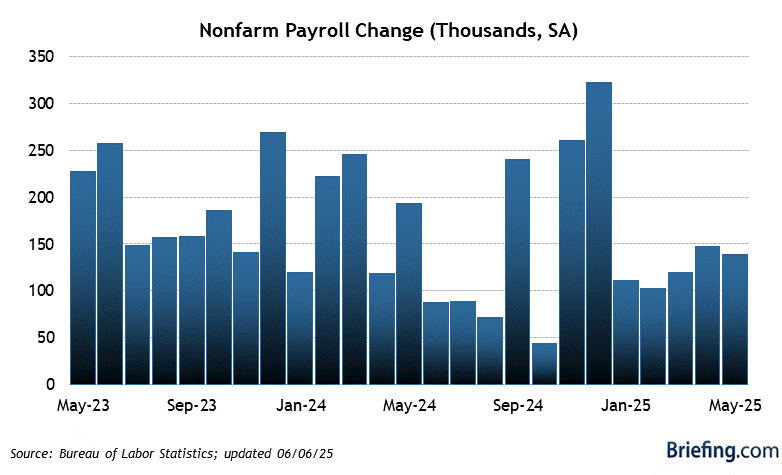Updated: 05-Sep-25 09:25 ET
| August Nonfarm Payrolls |
| Updated: 05-Sep-25 09:25 ET |




Highlights
- Payroll growth was somewhat anemic in August (additional revisions for June payrolls produced job losses that month); the U-6 unemployment rate, which accounts for unemployed and underemployed workers, jumped to 8.1% from 7.9%; the number of workers unemployed for 27 weeks or more accounted for 25.7% of the unemployed versus 24.9% in July; manufacturing sector payrolls declined by 12,000; and average hourly earnings growth decelerated on a year-over-year basis.
Key Factors
- August nonfarm payrolls increased by 22,000 (Briefing.com consensus: 78,000). The 3-month average for total nonfarm payrolls increased to 29,000 from 28,000. July nonfarm payrolls revised to 79,000 from 73,000. June nonfarm payrolls revised to -13,000 from 14,000.
- August private sector payrolls increased by 38,000 (Briefing.com consensus: 90,000). July private sector payrolls revised to 77,000 from 83,000. June private sector payrolls revised to -27,000 from 3,000.
- August unemployment rate was 4.3% (Briefing.com consensus: 4.3%) versus 4.2% in July. Persons unemployed for 27 weeks or more accounted for 25.7% of the unemployed versus 24.9% in July. The U6 unemployment rate, which accounts for unemployed and underemployed workers, increased to 8.1% from 7.9% in July.
- August average hourly earnings were up 0.3% (Briefing.com consensus: 0.3%) versus 0.3% in July. Over the last 12 months, average hourly earnings have risen 3.7% versus 3.9% for the 12 months ending in July.
- The average workweek in August was 34.2 hours (Briefing.com consensus: 34.3) versus a downwardly revised 34.2 hours (from 34.3) in July. Manufacturing workweek edged down to 40.0 hours from 40.1 hours. Factory overtime was unchanged at 2.9 hours.
- The labor force participation rate increased to 62.3% from 62.2%.
- The employment-population ratio held at 59.6%.
Big Picture
- The key takeaway is that the overall report leaned to the softer side of things, which isn't great economically speaking, yet, because it leaned that way, it also fortified the market's belief that there will be a rate cut at the September FOMC meeting and its hope that there will be additional rate cuts at the October and December FOMC meetings-a view that is supportive for a market pining for rate cuts.
| Category | AUG | JUL | JUN | MAY | APR |
| Establishment Survey | |||||
| Nonfarm Payrolls | 22K | 79K | -13K | 19K | 158K |
| Goods-Producing | -25K | -8K | -21K | -13K | 2K |
| Construction | -7K | -1K | -2K | 2K | 0K |
| Manufacturing | -12K | -2K | -17K | -11K | 0K |
| Service-Providing | 63K | 85K | -6K | 82K | 131K |
| Retail Trade | 11K | 7K | -5K | -15K | 5K |
| Financial | -3K | 9K | -6K | 7K | 5K |
| Business | -17K | -10K | -24K | -23K | 27K |
| Temporary help | -10K | -10K | -10K | -15K | 17K |
| Education/Health | 46K | 77K | 51K | 70K | 85K |
| Leisure/Hospitality | 28K | 6K | -5K | 27K | 18K |
| Government | -16K | 2K | 14K | -50K | 25K |
| Average Workweek | 34.2 | 34.2 | 34.2 | 34.3 | 34.3 |
| Production Workweek | 33.7 | 33.7 | 33.6 | 33.7 | 33.7 |
| Factory Overtime | 3.8 | 3.7 | 3.7 | 3.6 | 3.6 |
| Aggregate Hours Index | 0.0% | 0.1% | -0.3% | 0.1% | 0.1% |
| Avg Hourly Earnings | 0.3% | 0.3% | 0.2% | 0.4% | 0.2% |
| Household Survey | |||||
| Household Survey | |||||
| Civilian Unemp. Rate | 4.3% | 4.2% | 4.1% | 4.2% | 4.2% |
| Civilian Labor Force | 436K | -38K | -130K | -625K | 544K |
| Civilian Employed | 288K | -260K | 93K | -696K | 461K |
| Civilian Unemployed | 148K | 221K | -222K | 71K | 83K |
|
|